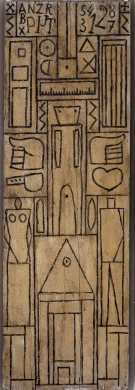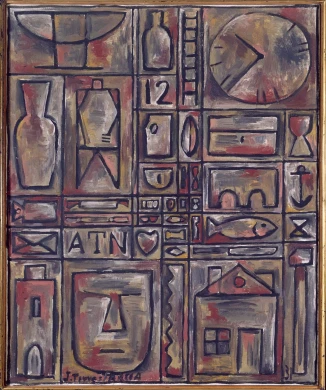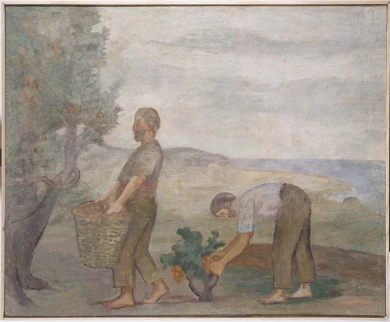
Numerario
- Técnica
- Talla
- Dimensiones
- Dimensiones variables
- Año de ingreso
- 2023
- Número de registro
- DE02602
- Fecha
1927-1928 (ca.)
- Materia
Madera y pintura
«Si el niño rompe sus juguetes, es, en primer término, para investigar; después para modificar: conocimiento y creación. Démosle, pues, los juguetes a piezas, y que haga lo que quiera. Así nos adaptaremos a su psicología.» Con esta frase, Joaquín Torres García presentó los juguetes de madera que comenzó a diseñar en 1917 y que expuso en Barcelona en las Galeries Dalmau, las Galeries Laietanes o la Universitat Industrial antes de su partida hacia Nueva York en 1920. Tras desembarcar del vapor Leopoldina y sorprendido por la nueva ciudad mecánica, fundó Artist Toy Makers con el propósito de renovar su producción artística. El ambiente urbano y cultural neoyorquino marcó la nueva estética y temática de sus juguetes, incluyendo fábricas, ciudades y figuras metropolitanas caricaturizadas a las que denominó Funny People.
En 1922, ante la falta de talleres de carpintería interesados por sus diseños, fundó en Florencia Aladdin Toy Co., una nueva sociedad industrial con la que se dedicó a producir juguetes a gran escala hasta su traslado a París en 1926. En esta última etapa parisina, antes de su regreso a Montevideo en 1934, es cuando se fecha este Numerario. Centrada en la utilidad educativa de los juguetes y la estructuración perceptivo-motriz del niño mediante ejercicios de descomposición y recomposición, la producción de estos «pequeños objetos de arte» se convirtió en un proyecto familiar. En el diseño de numerarios y abecedarios colaboraron activamente sus hijos Olimpia y Augusto y su esposa Manolita Piña de Rubies, interesada también en las teorías educativas renovadoras de Maria Montessori, Friedrich Fröbel y Ovide Decroly.
Francisco Javier Rodríguez Sepúlveda
“If a child breaks his toys, it is first to investigate, then to modify: knowledge and creation. Give him, then, the toys in pieces and let him do as he pleases. That way, we will adapt to his psychology”. With this sentence Joaquín Torres García presented the wooden toys he had started to design in 1917, exhibiting them in Barcelona at the Dalmau and Laietanes Galleries and at Universitat Industrial prior to his departure for New York in 1920. After arriving in the Leopoldina steamship and struck by the new mechanical city he encountered, he founded Artist Toy Makers for the purposes of overhauling his artistic output. New York’s urban and cultural environment saw him forge a new aesthetic and theme in his toys, including factories, cities and caricatured metropolitan figures he would call Funny People.
In 1922, faced with the lack of carpentry workshops interested in his designs, he founded in Florence the Aladdin Toy Co., a new industrial company with which he produced large-scale toys before finally moving to Paris in 1926. It is from this last period mentioned, in Paris, and before his return to Montevideo in 1934, that this Numerario (Numerary) dates. Focused on the educational use of the toys and children’s perceptive-motor structuring via exercises to disassemble and recompose, the production of these “small art objects” became a family project. In the design of numeraires and spelling books he would work actively with his children Olimpia and Augusto and his wife Manolita Piña de Rubies, who was also interested in the revolutionary theories of Maria Montessori, Friedrich Fröbel and Ovide Decroly.
Francisco Javier Rodríguez Sepúlveda
Galería de imágenes







